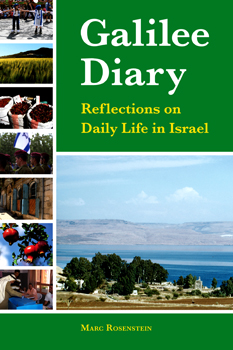
Spread over us the sukkah of Your peace. Blessed are You O Lord, who spreads out a sukkah of peace over us, over the entire people Israel, and over Jerusalem. -from the evening service
In the old country, that spacious land of garages and basements, we always had a serious sukkah, interchangeable panels of masonite on frames of 2 x 3’s with 2 x 6 rafters, that could be bolted together in less than an hour to yield a solid sukkah, and easily disassembled after the holiday and stowed until next year.
In 1982, when we came for a three-year sojourn in Jerusalem, building – and especially storing – such a sukkah was out of the question in our apartment, so we bought the Israeli standard – a snap-together frame of 5/8 inch square steel tubing, onto which one tied muslin walls. Not very solid or satisfying or aesthetic, but it was a sukkah, and you could store it through the year even in a small apartment. At the end of the three years we donated it to friends, returned to the US, and built ourselves a new, solid, wooden panel sukkah, complete with windows and curtains.
Five years later, when we returned to Israel on aliyah, our friends informed us that they were upgrading, and would be happy to return our bundle of steel tubing. That was 22 years ago. The frame brackets have rusted a bit, but a drop of oil each year keeps them functional. The fabric has been replaced several times, this year with a panel that has a window sown into it. Our new patio table just fits, so we can, with a bit of a squeeze, seat 12 for dinner. Most municipalities in Israel have their trees trimmed the week before Sukkot and leave the prunings for people to take home to roof their sukkot; in our rural county the JNF prunes sections of forest and piles the branches at pickup points for the residents.
A few years ago I abandoned the ritual of nervously driving down the highway with a pile of branches precariously tied to my car roof, when I discovered that I could come up with enough s’chach, or decorations, for our sukkah by trimming the trees in our own yard. It is the somewhat disorderly and variegated s’chach, and the decorations hanging from it, that make the sukkah beautiful, and no one even notices the flimsy construction.
There is a concept in Judaism of “hiddur mitzvah,” of beautifying the mitzvoth, meaning that one should invest in the aesthetics of observance, to indicate that we treasure the opportunity. Hence, silver candlesticks and kiddush cups, and fine china for the seder, and the rich fabrics and woods and stained glass with which we decorate our synagogues. I appreciate the logic of hiddur mitzvah; there is something to showing honor to our rituals, and making a connection between holiness and beauty. The one time when it seems to me that the concept has been pushed to absurdity is in the high prices that some Jews are willing to pay for a “perfect” etrog or lulav – which will be discarded in a week – and which raises the question of why all etrogim created by a perfect God are not ipso facto perfect…
When I take my rusty steel frame out to set it up, I feel a certain nostalgia for our impressive sukkah in the Diaspora, certainly an example of hiddur mitzvah, and toy with the idea of recreating it here, but quickly drop the thought when I realize I have no place to keep it, and besides, it seems a lot of wood to waste in a country which imports all of its wood. And then I comfort myself with the thought that my compact, modest, 30 year-old sukkah perhaps just captures the meaning of the holiday: Dwelling in the sukkah is about our vulnerability to the elements; about feeling what it’s like to make do without the comforts of civilization, dependent only on God; about getting by on minimal resources. Indeed, maybe a solid sukkah is even sort of an oxymoron. Moreover, if we dwelt in sukkot while traversing the desert, we certainly had no interest in frames made of 2 x 3s. A compact bundle of steel tubes would have been just the thing. And when it comes to the hot wind of the chamsin, or the first rain, or the wasps, in the end it doesn’t matter what your sukkah is made of. The point is to dwell in it in joy.
Chag sameach!
Originally published in Ten Minutes of Torah, a daily e-mail on a topic of Jewish interest. Sign up now to add 10 minutes of Jewish learning to your life each day!
Related Posts

Journey from Poland to Israel


